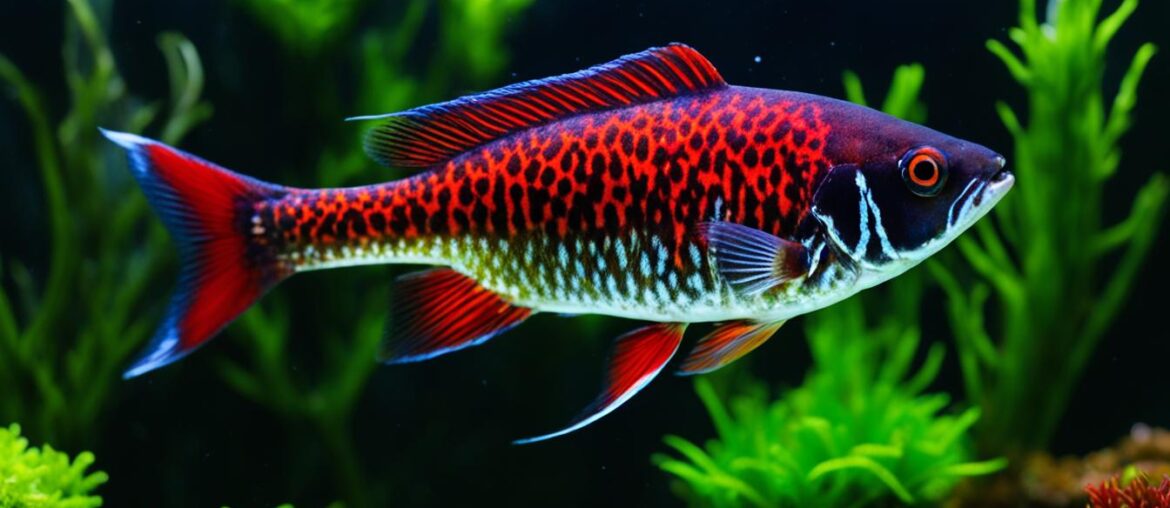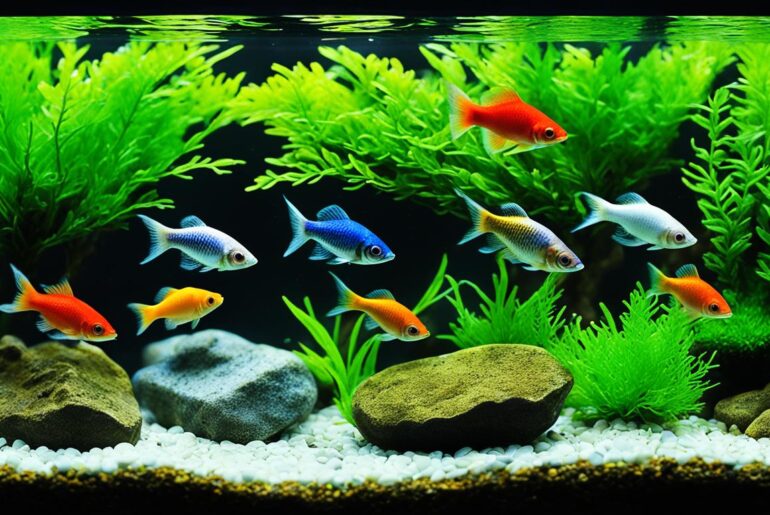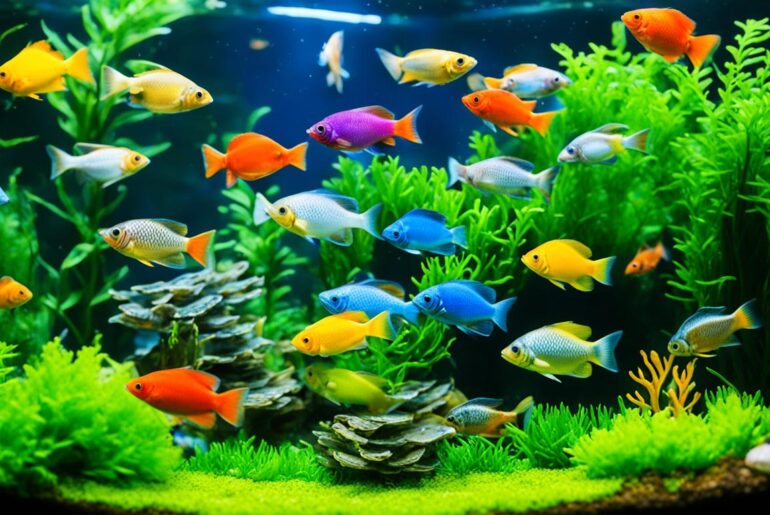Have you ever dreamed of transforming your aquarium into an underwater wonderland? Imagine vibrant bursts of color and unique fish species gracefully swimming among the plants. If you’re ready to take your aquarium to the next level, then rare and exotic freshwater fish might be just what you’re looking for.
When it comes to freshwater fish, most people think of the common goldfish or guppies. But did you know that there are rare and exotic fish species that can add a touch of magic to your tank? These unique freshwater fish are usually found in the waters of South America, Africa, and Asia, and they are highly sought after by collectors.
In this article, I will introduce you to five astonishing rare and exotic freshwater fish that will make your aquarium the envy of every fish enthusiast. From the stunning Discus fish to the captivating Flowerhorn Cichlid, each species has its own distinct qualities and care requirements. So, if you’re ready to dive into the world of rare fish breeds, let’s get started!
Key Takeaways:
- Discover five rare and exotic freshwater fish that can transform your aquarium.
- These unique fish species are usually found in South America, Africa, and Asia.
- Each fish has its own distinct characteristics and care requirements.
- Rare and exotic freshwater fish are highly sought after by collectors.
- Get ready to take your aquarium to the next level with these stunning fish.
Discus
Discus, a native of the Amazon river delta, is a calm and beautiful fish easily recognizable for its thin, disk-shaped body. This species comes in a diverse array of gorgeous colors and patterns, making them a delight to behold in any aquarium. However, due to their delicate nature, they are more suitable for experienced aquarists. They should be kept in tanks of at least 75 gallons and fed with algae flakes, tropical flakes, or shrimp pellets. Discus are peaceful and can get along with other freshwater fish, but they thrive best with other members of their species.
Discus fish are renowned for their vibrant colors and unique patterns, which can vary greatly between individuals. From electric blues and fiery reds to geometric patterns and iridescent scales, the visual spectacle they offer is truly breathtaking. Keeping a group of Discus fish in your aquarium will create a captivating display of color and movement.
Wolf Cichlid
The Wolf Cichlid is a striking and bold freshwater fish known for its territorial personality. With its silver to gold coloration and blue, black, green, and purple scales, these fish are remarkably good-looking.
They are best housed in a 200-gallon tank to provide enough space for their movement. Wolf Cichlids are not fond of sharing the spotlight with other tank mates, and they have a habit of uprooting plants, so it’s best to keep them with fish of their own species.
They are intelligent and can bond with their owners, but they require consistent care and a varied diet of bugs, bloodworms, and small crustaceans.
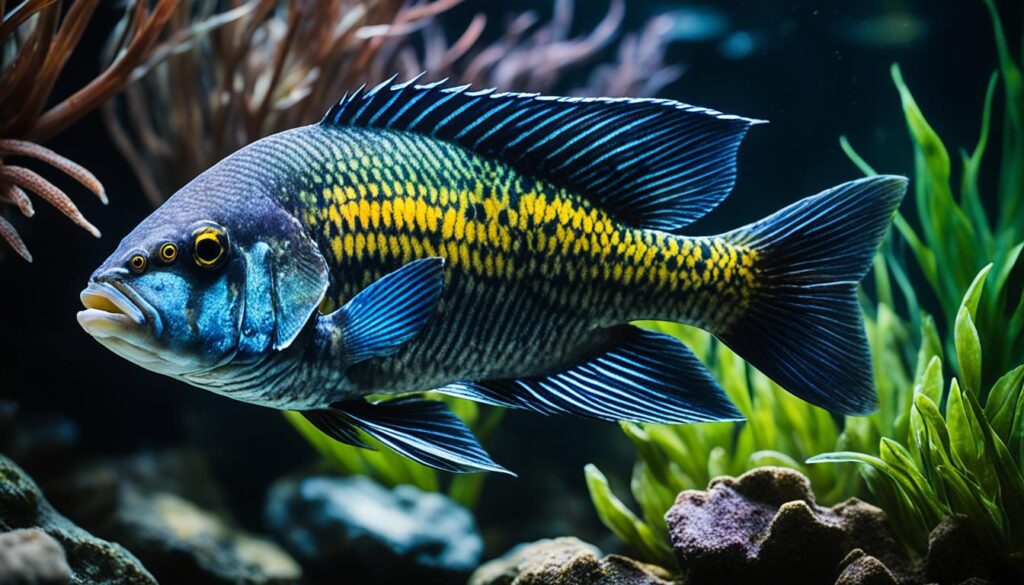
A stunning Wolf Cichlid prominently displaying its beautiful coloration and scales.
Flowerhorn Cichlid
Behold the magnificent Flowerhorn Cichlid, a truly unique and captivating freshwater fish. With its distinct horn-like growth on top of its head and a dazzling array of vibrant colors, this fish is a true showstopper in any aquarium.
These interactive and intelligent fish possess a delightful personality and love to bond with their owners. Their playful nature and inquisitive behavior make them a joy to observe and interact with.
Adding a Flowerhorn Cichlid to your aquarium is an excellent way to infuse a burst of vivid hues and energy. These captivating fish are available in a variety of color patterns, from fiery reds and oranges to striking blues and purples.
However, it’s important to note that the Flowerhorn Cichlid is known for its aggressiveness towards other freshwater fish. To ensure a harmonious tank environment, it’s best to keep them with members of their own species.
Providing adequate space is crucial for the comfort and well-being of Flowerhorn Cichlids. They require a tank of at least 75 gallons to accommodate their active nature. Additionally, maintaining optimal water conditions and regular filtration is important for their health.
To keep your Flowerhorn Cichlid happy and healthy, a varied diet is essential. They thrive on a combination of crickets, mealworms, and frozen shrimp, providing them with the necessary nutrients to thrive.
Key Characteristics of Flowerhorn Cichlids:
- Distinctive horn-like growth on top of the head
- Vibrant and eye-catching color patterns
- Interactive and intelligent nature
- Aggressive towards other freshwater fish
- Requires at least a 75-gallon tank
- Diet consists of crickets, mealworms, and frozen shrimp
Why Choose the Flowerhorn Cichlid?
“The Flowerhorn Cichlid is a remarkable freshwater fish that truly captures the attention of aquarium enthusiasts. Its unique appearance and engaging personality make it a standout choice for those seeking an extraordinary addition to their collection.”
Comparison Table: Flowerhorn Cichlid vs. Other Exotic Fish Species
| Species | Appearance | Temperament | Tank Size Requirement | Diet |
|---|---|---|---|---|
| Flowerhorn Cichlid | Distinct horn-like growth and vibrant color patterns |
Aggressive towards other fish Bonds with owners |
At least 75 gallons | Crickets, mealworms, frozen shrimp |
| Discus Fish | Wide variety of colors and patterns | Peaceful | At least 75 gallons | Algae flakes, tropical flakes, shrimp pellets |
| Wolf Cichlid | Silver to gold coloration, blue, black, green, and purple scales |
Territorial | At least 200 gallons | Bugs, bloodworms, small crustaceans |
Dwarf Puffer Fish
Are you a beginner aquarist looking for a small and adorable fish for your aquarium? Look no further than the Dwarf Puffer Fish. These pint-sized fish are perfect for novice fish keepers and can bring a playful charm to your tank.
The Dwarf Puffer Fish is known for its petite size, reaching a maximum length of 2.5 inches. This small stature means they only require a 10-gallon tank, making them ideal for those with limited space or smaller tanks.
With their greenish-brown coloration and distinctive ability to move their eyes independently of their bodies, Dwarf Puffers are both visually appealing and fascinating to observe. Their unique characteristic adds to their charm and makes them even more captivating.
While Dwarf Puffers are friendly and interactive with their owners, they can be aggressive towards other fish. However, they do get along well with their fellow Dwarf Puffers, so consider keeping them in a species-only tank to avoid any conflicts.
To ensure the health and well-being of your Dwarf Puffer Fish, it’s essential to maintain low ammonia levels in the tank. Regularly cleaning the tank and performing water changes are crucial for their overall care.
Remember: These tiny fish have big personalities, and providing them with a suitable and well-maintained environment is key to their happiness and longevity.
| Key Features of Dwarf Puffer Fish | |
|---|---|
| Size | Up to 2.5 inches |
| Tank Size | 10 gallons |
| Coloration | Greenish-brown |
| Compatibility | Aggressive towards other fish, but can coexist with other Dwarf Puffers |
| Special Characteristics | Eyes can move independently of their bodies |
Dwarf Puffer Fish are a delightful addition to any aquarium, providing a splash of personality and character. Their small size and beginner-friendly nature make them an excellent choice for those starting their aquatic journey.
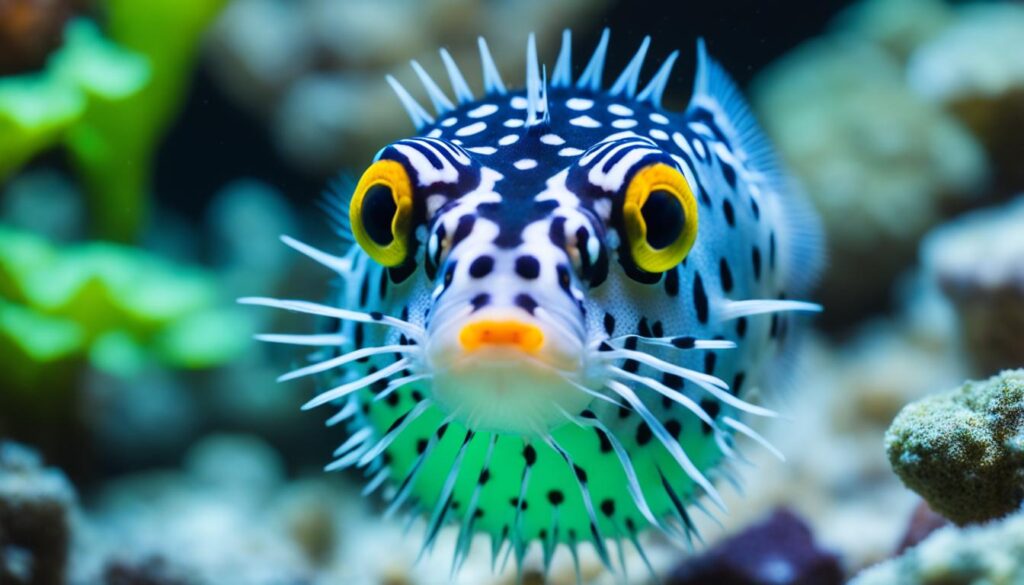
Stay tuned for the next section where we’ll explore another fascinating rare and exotic freshwater fish.
Zebra Plecos
If you’re a beginner aquarist looking for a unique addition to your aquarium, look no further than the Zebra Plecos. These fascinating freshwater catfish are known for their striking black and white color pattern, making them a standout among other fish species.
The Zebra Plecos are native to the Amazon river, where they prefer to live in small caves and between rocks. To ensure their well-being, it’s important to provide them with a tank of at least 30 gallons that offers plenty of hiding spots to accommodate their natural behavior.
One interesting characteristic of Zebra Plecos is that they are nocturnal, meaning they are most active during the night. This makes them a captivating addition to your aquarium, as you can observe their behavior during the darker hours.
Aquascaping with Zebra Plecos can create a visually stunning underwater landscape. Their bold coloration contrasts well with various aquatic plants and decorations, adding depth and visual interest to your tank.
When it comes to their diet, Zebra Plecos are omnivorous and require a balanced meal plan. Including items such as algae wafers, freeze-dried tubifex, and live or frozen brine shrimp in their diet will ensure they receive the necessary nutrients to thrive.
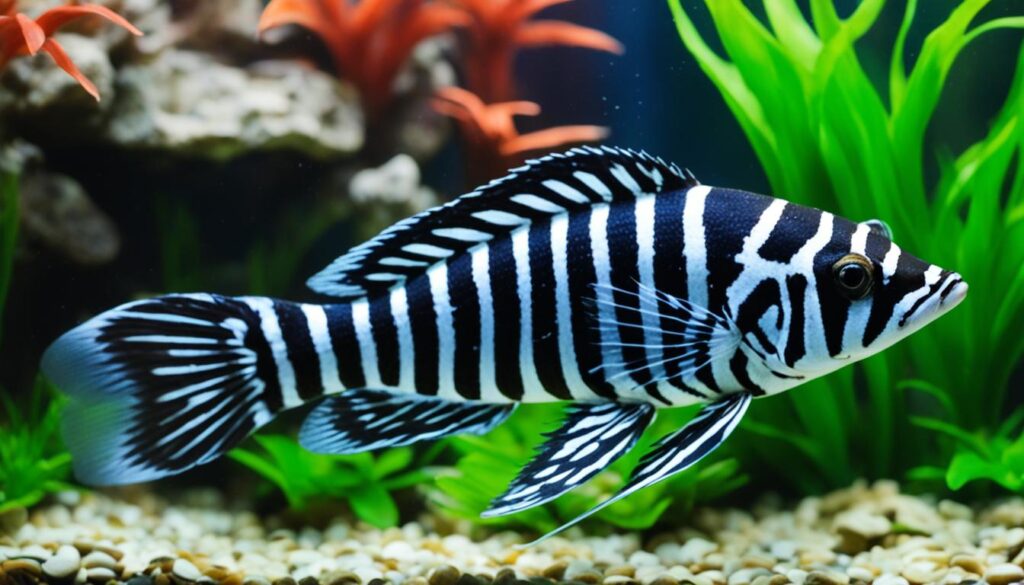
Introducing Zebra Plecos to your aquarium can be a rewarding experience. With their unique appearance, nocturnal habits, and compatibility with aquascaping, they are sure to become a centerpiece of your aquatic world. Their ease of care makes them an ideal choice for beginner aquarists who want to embark on a journey of freshwater fishkeeping.
Black Ghost Knifefish
The Black Ghost Knifefish is a unique freshwater fish that stands out with its sleek, narrow body resembling a knife and its striking black color. This mesmerizing fish is a favorite among aquarium enthusiasts looking for something truly special to add to their collection.
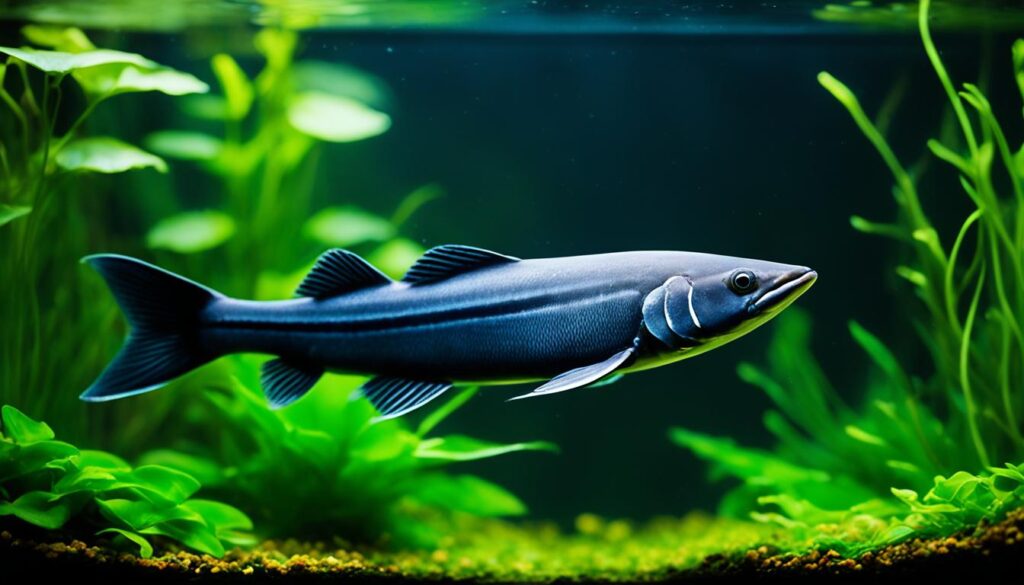
What makes the Black Ghost Knifefish truly fascinating is its adaptation to low-light environments. These fish have excellent vision and can navigate using electromagnetic fields. This remarkable ability allows them to thrive in aquariums with subdued lighting, creating a captivating ambiance in your tank.
When it comes to temperament, the Black Ghost Knifefish is known for its peaceful nature. They prefer to live harmoniously and are compatible with other non-aggressive freshwater fish species. To ensure a tranquil environment, it’s important to avoid keeping them with any aggressive tank mates.
Black Ghost Knifefish are timid by nature and tend to stay hidden during the day. As nocturnal creatures, they come alive at night, gliding through the water with grace. It’s essential to provide your Knifefish with plenty of hiding spots in the aquarium, such as caves and driftwood, to make them feel secure and comfortable.
These majestic fish require a spacious environment to thrive, so it’s recommended to keep them in large tanks of at least 150 gallons. This ample space allows them to swim freely and exhibit their natural behaviors. Maintaining optimal water conditions and regular tank maintenance will ensure the health and well-being of your Black Ghost Knifefish.
Feeding the Black Ghost Knifefish
When it comes to their diet, these fish have a varied appetite. Black Ghost Knifefish are omnivorous, which means they eat both meaty and plant-based food. To provide a balanced diet, you can feed them a combination of live worms, frozen meat, and high-quality freshwater flakes.
Black Ghost Knifefish Care Guide
- Ensure a spacious tank of at least 150 gallons
- Create hiding spots with caves and driftwood
- Maintain low-light environments
- Keep the aquarium clean and well-regulated
- Provide a varied diet with live worms, meat, and freshwater flakes
- Keep peaceful tank mates
With their unique appearance and adaptability to low-light environments, the Black Ghost Knifefish is truly a captivating addition to any aquarium. Their peaceful nature, combined with their large size and intriguing behavior, makes them a prized fish for enthusiasts looking for something extraordinary.
Freshwater African Butterflyfish
The Freshwater African Butterflyfish is an ancient fish species, with a morphology that has remained unchanged for over 100 million years. These slow-moving fish are a unique addition to any aquarium, known for their long fins that resemble wings. With their frown-shaped mouths, they are perfectly adapted to catching small fish and bugs in the water.
Most Butterflyfish have a dark brown color with a speckled pattern, allowing them to blend in effortlessly with aquatic plants. While they can coexist with other fish in a community tank, it is not advisable to keep them with smaller fish, as their predatory nature may cause harm.
When it comes to their diet, Freshwater African Butterflyfish thrive on a menu that includes brine shrimp, bugs, and frozen foods. These slow-moving fish are best appreciated in a serene setting, where their unique beauty and ancient lineage can truly shine.

Most Expensive Freshwater Fish
When it comes to freshwater fish, there are some rare and exotic species that can come with a hefty price tag. These high-priced aquarium fish are sought after by collectors and enthusiasts alike. From the Asian Arowana to the Peppermint Angelfish and the Discus Fish, there is no shortage of rare fish species that can make a big dent in your wallet. The cost of these fish can range from hundreds to even hundreds of thousands of dollars, depending on factors such as breed, size, and rarity.
If you’re an aquarium hobbyist looking to add something truly unique and extraordinary to your tank, these exotic fish for aquarium can be a true showstopper. Their stunning colors, intricate patterns, and graceful movements make them a captivating centerpiece. However, it’s important to consider the specific care requirements of these high-priced aquarium fish, as they may require special attention and a carefully maintained environment to thrive.
Here is a table showcasing some of the most expensive freshwater fish and their approximate prices:
| Fish Species | Approximate Price Range |
|---|---|
| Asian Arowana | $5,000 – $300,000 |
| Peppermint Angelfish | $30,000 – $50,000 |
| Discus Fish | $100 – $500 |
| Redtail Catfish | $500 – $2,000 |
| Freshwater Stingray | $1,000 – $10,000 |
Note: The prices mentioned above are just approximate ranges and can vary depending on various factors such as the fish’s size, coloration, rarity, and the market demand.
While these high-priced aquarium fish can be a major investment, for true enthusiasts they are worth every penny. Owning these rare and exotic fish is like having a living work of art in your own home. However, it’s important to remember that proper care and maintenance are essential to ensure their well-being. If you’re considering adding one of these extravagant species to your aquarium, make sure to do thorough research and consult with experts to ensure that you can provide them with the ideal habitat and care they require.
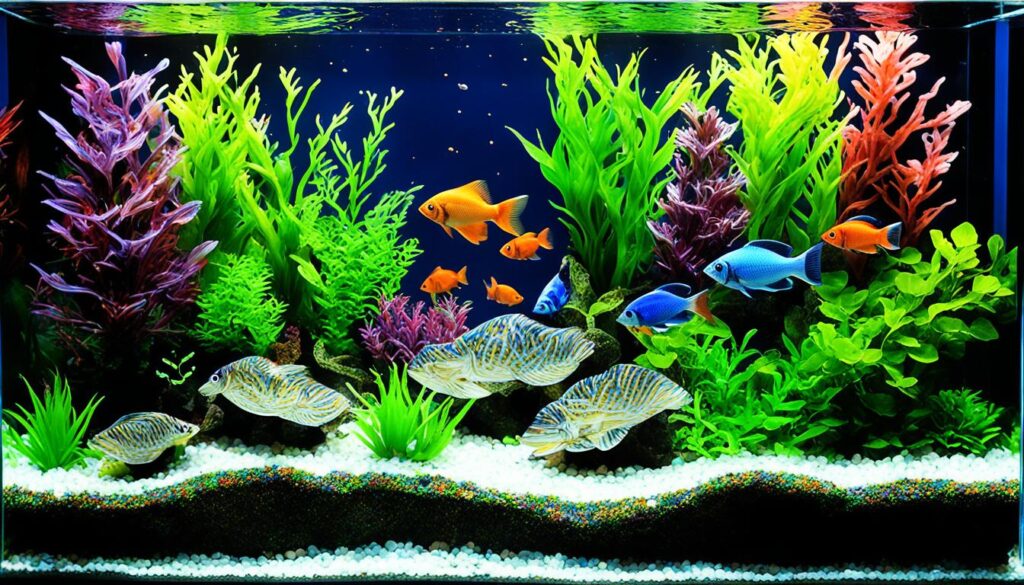
Conclusion
In conclusion, rare and exotic freshwater fish can add a touch of vibrancy and uniqueness to your aquarium. From the Discus fish to the Wolf Cichlid, each species has its own distinct characteristics and care requirements. Whether you’re an experienced aquarist or a beginner, there is a rare fish out there that can fascinate and delight you.
Just keep in mind that these fish may come with higher price tags due to their rarity. If you’re ready to dive into the unique world of rare and exotic fish, one of the fish species mentioned in this article may be the perfect match for your aquarium.
FAQ
Are Discus fish suitable for beginners?
Discus fish are not recommended for beginners due to their delicate nature and specific care requirements. They are more suitable for experienced aquarists.
What is the ideal tank size for keeping Wolf Cichlids?
Wolf Cichlids require a tank size of at least 200 gallons to provide enough space for their movement and territorial behavior.
Can Flowerhorn Cichlids live peacefully with other freshwater fish?
No, Flowerhorn Cichlids are known to be aggressive towards other freshwater fish. It’s best to keep them with members of their own species.
What size tank is recommended for Dwarf Puffer Fish?
Dwarf Puffer Fish only require a 10-gallon tank to thrive. They are a great choice for beginners with smaller aquarium setups.
How should Zebra Plecos be fed?
Zebra Plecos should be fed a diet that includes algae wafers, freeze-dried tubifex, and live or frozen brine shrimp. These fish have specific feeding requirements.
What kind of tank setup is suitable for Black Ghost Knifefish?
Black Ghost Knifefish require a tank with enough hiding spots as they are timid and usually come out at night. Keeping them with peaceful freshwater fish is ideal.
What do Freshwater African Butterflyfish feed on?
Freshwater African Butterflyfish feed on small fish and bugs. It’s important to provide them with a diet that includes brine shrimp, bugs, and frozen foods.
What are the most expensive freshwater fish?
The costliest freshwater fish include the Asian Arowana, Peppermint Angelfish, and Discus Fish. The price depends on factors such as breed, size, and rarity.
